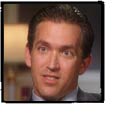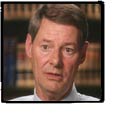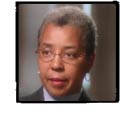 |




The supervising deputy district attorney for the Juvenile Division of the Santa
Clara County's District Attorney's office, he's practiced exclusively in
juvenile court for the past six years. He was the prosecutor for Manny's
fitness hearing.

...Having [been a prosecutor] now for nearly 12 years, I have seen time and
time and time again kids who were lost causes turn their lives around. And 80
percent of the kids that come before us one time never come back. . . .
... Based on your experience, what works with serious juvenile offenders and
what doesn't work?
There is no one answer with respect to rehabilitation for anyone. Juvenile
rehabilitation is an art and not a science. What works for one kid may not
work for another. And so what you try to do is to do as many things as
possible, hoping that something works. Juvenile rehabilitation might be a lot
like taking swings at a piñata. And the more swings you take, the
better the chance is that you will hit it right and something will come out. I
do think that if you take a look at the thousands of kids that I've dealt with
over a decade or more, the idea is to do something that is significant early
on. If you reach a kid early, chances are they won't re-offend. But with each
additional entry into the system our success, our potential for rehabilitation
gets slimmer and slimmer. . . .
When you talk about doing something significant early on, what tools do you
have in your kit bag other than serious punishment?
Oh, there are a number of things, depending upon the age of the offender. You
can modify behavior with respect to association, with respect to school
attendance, with respect to alcohol and drug counseling. You can monitor
behavior with respect to gang affiliation, search and seizure. You can help
parents become better parents, if you are creative. You can enlist the court
to set up programs that, frankly, in the past were more the province of schools
and afterschool programs and churches and other community safety nets.
Unfortunately, they don't seem to have the same role in society that they used
to have. There are a whole of things that you can do in juvenile court that,
frankly, adult court just doesn't do. . . .
We talked to some kids . . . who are locked up right now for certain acts.
We talked about some of the behavior that they think led up to that. A lot of
it had to do with feeling like nobody else cared about them, or feeling
disrespected by everybody else unless they belonged to something bigger than
themselves, and the only thing bigger than themselves that they knew about was
the gang. What responses are available now that really speaks to that
need?
What works is different for every kid, but the one rule that I think is
applicable, after years of seeing this, is "the sooner, the better." We need
to reach these kids with alternatives, with opportunities, before they start to
feel that way. If we took half of the money that we spend on incarceration and
put it in front-end programs to give these kids alternatives, then we wouldn't
have as many back-end kids that we needed to incarcerate. And I think that is
the immediate answer.
Why don't we?
I don't know. I think too often we get caught up in believing that we are in
an either-or society. You either have to be in favor of programs or
incarceration, that they are somehow mutually exclusive, that you either have
to have back-end "lock them up" money or front-end prevention money, and that
somehow the two of them can't be coalesced into some sort of a master plan.
And I think it's largely political. It plays upon public fears. . . .



Judge Hoffman served on the Superior Court of Santa Clara County, where she
handled both juvenile and adult cases. Marquese's fitness case was her last
case before retirement.

What does [the juvenile justice system] do well?
I think that it does well in cases that it is originally designed to deal with.
The original idea was, when a kid gets in trouble and is brought into court,
the judge sits down, is a friendly mentor and has a talk. The family is
involved and things get better.
But that's not the way the juvenile court now operates. It's very big, it's
very precise. Crimes are charged: the kid didn't hit another kid, he committed
an assault or an assault with a deadly weapon or a battery. All of the sudden,
the minor's there in court with an attorney telling him not to acknowledge that
he did a wrong, because punishment's going to be terrible. And I'm not saying
the kid shouldn't have an attorney, but that's what happens when we made this
system like a mini-adult system.
What would you change about the juvenile system if you were in
charge?
If I were in charge, I would like to have more intervention very early on
without charging crimes. Bring kids and families into court when kids are
splitting from school, or not doing well. I would like to see groups within
individual communities working with troubled families and youth, before they
get to middle school, and before they get to high school. And if they have to
come to court eventually, I would like to have had caring social workers--as
much as possible, the same culture and/or the same race as the minor--out there
to work with the family, to correct whatever is going on. Something is causing
the minor to do things like not go to school, stay out till three o'clock in
the morning, not get up for school and so on. There'd be much more intervening
in the family. We intervene with a minor, but there's very little done with
the family, and we're sending the minor right back in that situation.



Until recently he was the presiding judge of the Juvenile Court of Santa Clara
County, a division of the California Superior Court and presided over Shawn's
case. He heard between 300 and 350 cases a month.

If we have a failing as a society, from my very narrow, very unique perspective
as a juvenile court judge in my community, we fail families. We should be
helping to provide them with whatever services they need when the children are
very, very young. Now, that's easy to say, and I don't mean to indict the
community. We have wonderful resources, and we've got lots of money, at least
in this county and in this state. But we should be front-loading those
services and spending that money at the front end. And we should not be
waiting for problems to become so big and so nasty that we can't do much about
them at the back end. That's where we, as a society, have really made a big,
big mistake. Because when we start to deal with problems when they're very
small and help people become better parents in this case and families stronger
and healthier, we solve all kinds of messy stuff at the back end. It just
never happens. . . .
You have said that one reason you believe in rehabilitation is that you
really think kids can turn around, you've seen successes. And if you see it
and you hear it every day, why do you think the public doesn't see it?
Confidentiality. We operate behind a cloak of secrecy in the juvenile court
system and that's set by law; it's not my decision. I have to simply obey the
law the way it's written. That's another problem that we have. I think we
ought to get rid of this shield of confidentiality that keeps the public
scrutiny and the public presence out of the courtroom. We've got nothing to
hide here. We have our successes; I'm damn proud of them.
But we also need something more important. We need the involvement of the
community in what we do with their kids. All we're doing in here is trying to
deal with the problems facing our community's children, and I need their help.
I need their experience, I need their concern, I need their love, I need their
talent, and I can't do it with the door locked. So I would like to throw the
locks away and open the door and bring the sunshine of the community into my
courtroom. That's what I would like.



Former supervisor of the juvenile division of the Santa Clara County Public
Defender's Office, she represented Shawn at his disposition.

One of the frustrations that I truly have with the juvenile justice system is
the fact that we have so many opportunities to intervene before we get to the
point where someone's taking someone out, shooting them, beating them up.
There's generally a track record that leads up to that, especially in gang
cases. They start off doing graffiti, or they might start off doing a little
hand-to-hand. They don't doesn't stick a gun in somebody's hand and say, "Go
shoot them," right off the bat, at least not in my community.
So we've had opportunities to intervene and help provide some structure and
help figure out what's going on with this kid or his family or her family
before we get to the point where they're doing drive-bys. And that's extremely
frustrating for me. When we're talking about serious offenders, who I know
you're talking about in this piece, we have seen most of these young people
before. They didn't just show up with a serious offense. . . . Many of these
kids have grown up in detention facilities, when we could have done something
with them as a community. And therein is my frustration. . . .
What's your vision of society? Is the state supposed to be everybody's
parent?
No. My vision of society is that we have a community that gets involved. And
the juvenile justice system can certainly help the community get involved in a
better way than we have done. . . . If we could get the community engaged the
way it was when I was a kid, where you did some dirt on the next street, and
before you got home, Mom knew about it, because the community was engaged, they
knew you. They knew who you were, and they were willing to say, "Hey, stop,
maybe there's a better way to do that," or "What's going on?" To me, that's
the solution. . . . The juvenile justice system is a very poor parent. A very
poor parent. And yet they are tasked with the responsibility of rehabilitating
children.
. . .
...If you could fix it, if you could make it be the way you wanted it to be,
what would you do differently?
I would focus a lot on early intervention. I would put a lot more resource on
those kids that hit the system the first time coming through. I would spend
more time and energy to figure out who they are and why they're there, and then
provide resources. I would try to figure out what their strengths are and
build upon those. I would spend a lot of time doing a lot of PR work in terms
of the community, trying to connect the community and kids. There's a lot that
I would do on that front end to make sure that kids don't escalate through our
systems. They shouldn't be escalating. This should not be a revolving door
type of system until we just get sick of it and decide, "Throw them away, it's
not worth it." We have a chance to intervene.



Until recently she served on the Superior Court of Santa Clara County, where she
heard both juvenile and adult cases. A state court trial judge since 1982, she
presided over Manny's fitness case.

Do you feel that the juvenile justice system does rehabilitate
youngsters?
It can. There are numbers of success stories. And there are some juveniles
who don't get [rehabilitated], for a lot of reasons, and then come back into
the system and at some point the system does give up. That's where we say,
"You're not fit any longer to be in the juvenile system; we're going to have to
move you to the adult system."
... I have had these young people come into my court charged with committing
some violent acts as serious as murder, but they had not gone into the adult
system, because it was a decision I made as a result of a fitness hearing that
this person indeed was amenable to treatment. And in some cases--not all, but
in some cases--I have been proved right. So I know that this can happen.
Lives can be turned around. . . .
The beauty of the juvenile justice system is that it can be applied and
modified to deal with the needs of the particular juvenile. That's what the
system is all about. And these kids ought to have an opportunity, if the law
says they can, to be a part of that system so we save them, so they become
productive. That's how society benefits. If not, fine; let's go spend a ton
of money every year and let's just lock these kids up. They're going to get
out one day, and they're going to be back here in our faces again, and we're
going to be spending more money than ever. So it just makes sense. Let's just
stop the buck here if we can, because we'll benefit, not only financially, but
just in terms of having individuals in society who do well.
... What would you do differently if you were in charge? What would you
change?
I'd put more money into the system, so that we would have more resources
available to work with kids. . . . That's number one. Number two is that we
have a system in which there are tremendous racial disparities in how kids are
treated. One of the main primary ways of changing that is to change the
complexion of the bench. There have to be more judges who look like the young
people who come in. And that means more judges of color, more women. . . . And
then it's going to take being very upfront with people in the system that this
problem exists in terms of the racial disparities and getting people to deal
with it. That means we have to put it on the front burner, and that means
leadership. . .

manny · shawn · marquese · jose
from both sides of the bench · facts & stats · related report: little criminals
discussion · synopsis · press · tapes & transcripts · credits
FRONTLINE · wgbh · pbs
web site copyright WGBH educational foundation
|  |